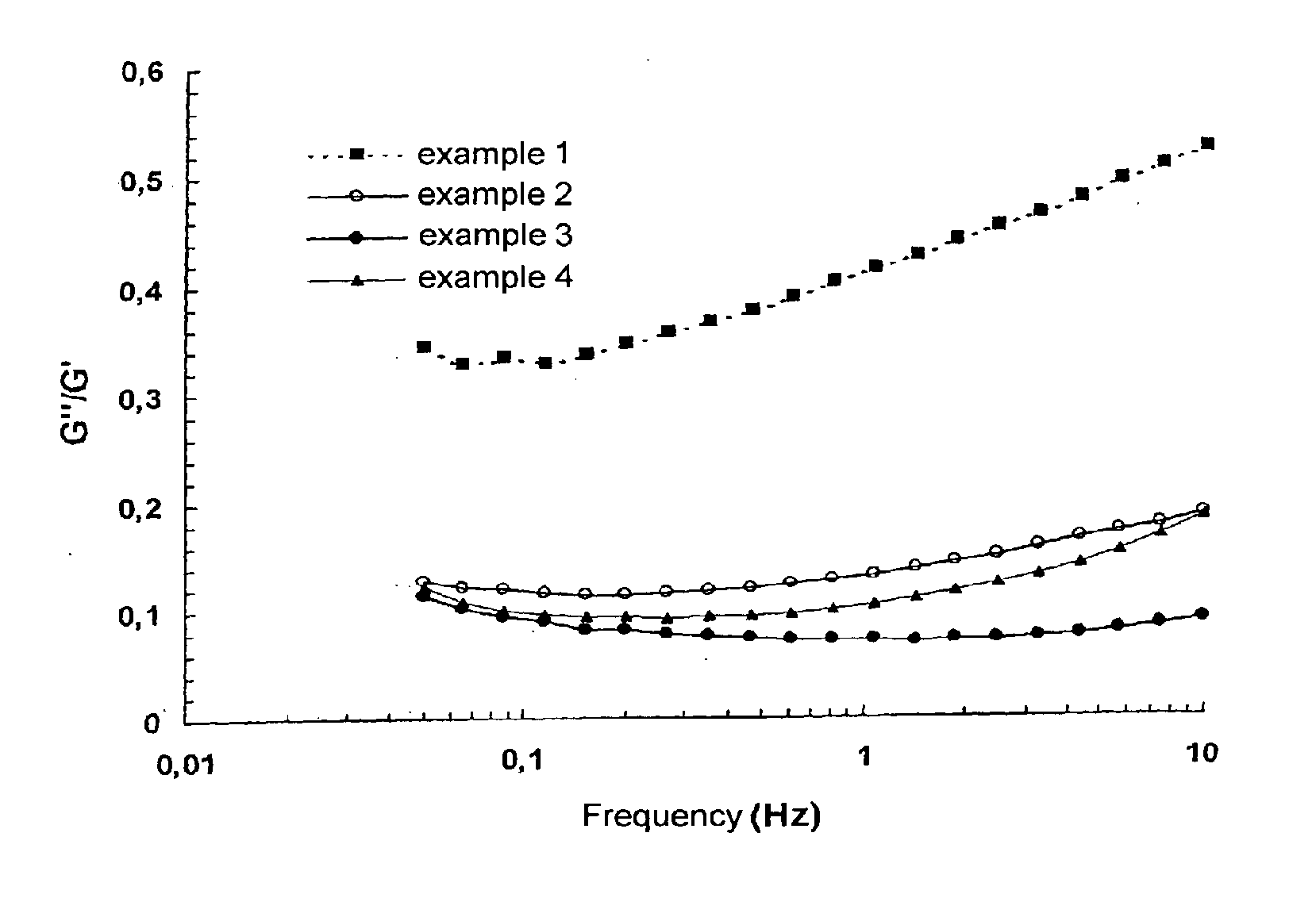Cross-linking of low-molecular weight and high-molecular weight polysaccharides, preparation of injectable monophase hydrogels, polysaccharides and hydrogels obtained
a high-molecular weight, polysaccharide technology, applied in the preparation of sugar derivatives, prosthesis, dentistry, etc., can solve the problems of chemical contamination of crosslinked products obtained, quick dumping, and solubility problems
- Summary
- Abstract
- Description
- Claims
- Application Information
AI Technical Summary
Benefits of technology
Problems solved by technology
Method used
Image
Examples
example 1
High-Molecular Weight Fibers
[0074]3.5 g of sodium hyaluronate (Naha) Fibers of Intrinsic Viscosity 2800 ml / g and moisture content 8.7% are weighed out and 25.6 g of 0.25 N NaOH are added. Hydration of the fibers takes 2 h with regular manual homogenization using a spatula. 0.96 g of a solution of 1,4-butanediol diglycidyl ether (BDDE) diluted to ⅕ in 0.25 N sodium hydroxide solution is added to the reaction medium, this being followed by mechanical homogenization for 15 min before immersion in a thermostatically controlled bath at 50° C.±1° C.
R=[BDDE]0 / [NaHA]0=6%; [NaHA]i=105 mg / g
[0075]The reaction takes 2 h. The crosslinked product is neutralized to pH 7.2 in a phosphate buffer solution and then dialyzed. The concentration of the resulting hydrogel is then adjusted ([NaHA]f=26 mg / g) and the hydrogel is mechanically homogenized before being packed into syringes and sterilized in an autoclave by means of moist heat.
[0076]Injection force after sterilization: 25 N
[0077]Remanence index ...
example 2
Low-Molecular Weight Fibers
[0079]1.56 g of sodium hyaluronate (NaHA) fibers of intrinsic viscosity 600 ml / g and moisture content 5.5% are weighed out and 7.15 g of 0.25 N NaOH are added. Hydration of the fibers takes 2 h with regular manual homogenization using a spatula. 0.31 g of a solution of 1,4-butanediol diglycidyl ether (BDDE) diluted to ⅕ in 0.25 N sodium hydroxide solution is added to the reaction medium, this being followed by mechanical homogenization for 15 min before immersion in a thermostatically controlled bath at 50° C.±1° C.
R=[BDDE]0 / [NaHA]0=6.8%; [NaHA]i=174 mg / g
[0080]The reaction takes 2 h. The crosslinked product is neutralized to pH 7.2 in a phosphate solution and then dialyzed. The concentration of the resulting hydrogel is then adjusted ([NaHA]f=26 mg / g) and the hydrogel is mechanically homogenized before being packed into syringes and sterilized in an autoclave.
[0081]Injection force after sterilization: 24 N
[0082]Remanence index of the hydrogel: 6.0
[0083]Bip...
example 3
Mixture of Fibers
[0084]0.763 g of sodium hyaluronate (NaHA) fibers of intrinsic viscosity 600 ml / g and moisture content 5.5% and 0.237 g of sodium hyaluronate fibers of intrinsic viscosity 2800 ml / g and moisture content 9.3% are weighed out. Proportions by weight
[0085]in the mixture: 600 / 2800:77 / 23 (w / w).
[0086]The procedure remains identical to that of Example 2.
R=[BDDE]0 / [NaHA]0=7%; [NaHA]i=140 mg / g; [NaHA]f=26 mg / g
[0087]Injection force after sterilization: 15 N
[0088]Remanence index of the hydrogel: 3.6
[0089]Monophase hydrogel
PUM
| Property | Measurement | Unit |
|---|---|---|
| molecular weight | aaaaa | aaaaa |
| molecular weight | aaaaa | aaaaa |
| molecular weight | aaaaa | aaaaa |
Abstract
Description
Claims
Application Information
 Login to View More
Login to View More - R&D
- Intellectual Property
- Life Sciences
- Materials
- Tech Scout
- Unparalleled Data Quality
- Higher Quality Content
- 60% Fewer Hallucinations
Browse by: Latest US Patents, China's latest patents, Technical Efficacy Thesaurus, Application Domain, Technology Topic, Popular Technical Reports.
© 2025 PatSnap. All rights reserved.Legal|Privacy policy|Modern Slavery Act Transparency Statement|Sitemap|About US| Contact US: help@patsnap.com



